research
-
 Minister of Higher Education of Saudi Arabia Visited KAIST to Sign Agreement on Joint Research Projects
Khaled bin Mohammad Al-Anqari, the Minister of Higher Education of Saudi Arabia, visited KAIST on October 26th to conclude a joint agreement with KAIST.
The group of Saudi Arabian visitors included Abdullah bin Abdularhman Al-Othman, President of the King Saud University, Osama bin Sadiq Tayeb, President of King Abdulaziz University, and Khalid bin Salih Al-Sultan, President of the best Saudi Arabian technological university, King Fahad University of Petroleum and Minerals.
Through research agreement between KAIST and the King Saud University and King Fahad University of Petroleum and Minerals, joint research projects, mutual visitations of research professors, interchange of academic programs, joint seminars and scientific societies will be held to promote the lively interchange between higher education institutions of Korea and Saudi Arabia.
In particular, King Saud University and KAIST has signed an agreement on joint research projects in the fields of “Solar-Ocean Thermal Exchange Desalination,” “Develop New Energy Management Service for Residential and Commercial Customers Using Smart Metering and Sensor Network Information” and “Superior Production of Lactic Acid from Saudi Dates Using Bioprocess Technology.”
The projects will be funded by the Saudi Arabian government, and their scope will be determined in the future
“Compared to the robust industrial economic interactions between the Middle East and Korea, the interchange of the two countries’ higher education institutions has been poor,” said Jong Hyun Kim, Visiting Professor of Nuclear & Quantum Engineering Department of KAIST who will be conducting one of the joint programs with the Electrical Engineering Department of the King Saud University. “Like this joint research, I hope KAIST will, in many different ways, lead the way in cooperating and interacting with higher education institutions of the Middle EAST.”
Al-Anquari, Minister of Higher Education of Saudi Arabia, who showed great interest in KAIST’s innovative research and high technology development, expressed his will to put more effort into extending the interchange between universities of Saudi Arabia and of Korea, including KAIST.
2010.11.03 View 17014
Minister of Higher Education of Saudi Arabia Visited KAIST to Sign Agreement on Joint Research Projects
Khaled bin Mohammad Al-Anqari, the Minister of Higher Education of Saudi Arabia, visited KAIST on October 26th to conclude a joint agreement with KAIST.
The group of Saudi Arabian visitors included Abdullah bin Abdularhman Al-Othman, President of the King Saud University, Osama bin Sadiq Tayeb, President of King Abdulaziz University, and Khalid bin Salih Al-Sultan, President of the best Saudi Arabian technological university, King Fahad University of Petroleum and Minerals.
Through research agreement between KAIST and the King Saud University and King Fahad University of Petroleum and Minerals, joint research projects, mutual visitations of research professors, interchange of academic programs, joint seminars and scientific societies will be held to promote the lively interchange between higher education institutions of Korea and Saudi Arabia.
In particular, King Saud University and KAIST has signed an agreement on joint research projects in the fields of “Solar-Ocean Thermal Exchange Desalination,” “Develop New Energy Management Service for Residential and Commercial Customers Using Smart Metering and Sensor Network Information” and “Superior Production of Lactic Acid from Saudi Dates Using Bioprocess Technology.”
The projects will be funded by the Saudi Arabian government, and their scope will be determined in the future
“Compared to the robust industrial economic interactions between the Middle East and Korea, the interchange of the two countries’ higher education institutions has been poor,” said Jong Hyun Kim, Visiting Professor of Nuclear & Quantum Engineering Department of KAIST who will be conducting one of the joint programs with the Electrical Engineering Department of the King Saud University. “Like this joint research, I hope KAIST will, in many different ways, lead the way in cooperating and interacting with higher education institutions of the Middle EAST.”
Al-Anquari, Minister of Higher Education of Saudi Arabia, who showed great interest in KAIST’s innovative research and high technology development, expressed his will to put more effort into extending the interchange between universities of Saudi Arabia and of Korea, including KAIST.
2010.11.03 View 17014 -
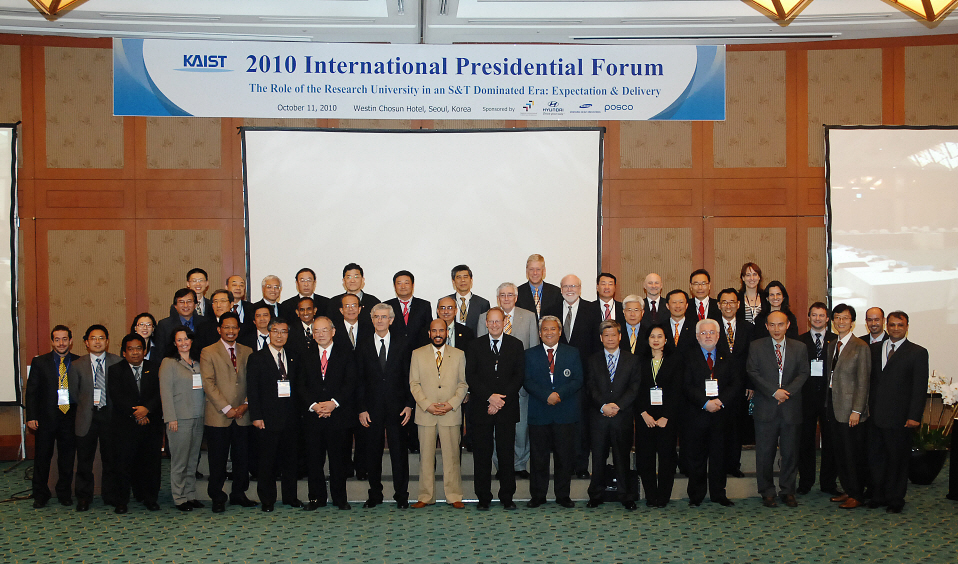 2010 International Presidential Forum was held successfully.
On October 11th, the 2010 International Presidential Forum on “The Role of the Research University in an S&T Dominated Era: Expectation & Delivery” was held successfully at the Westin Chosun Hotel in Seoul. The third International Presidential Forum to be held, participants of the 2010 Presidential Forum engaged in an in-depth discussion about the direction that research universities should take in the 21st Century.
On its opening, President Nam Pyo Suh delivered a congratulatory message saying, “This forum is a meaningful gathering where research universities will suggest role models and find ways research universities can contribute to the progress of mankind in this century.”
Following, Lee Ki Jun, CEO of the Korean Federation of Science and Technology Societies said, “The common goal of the world’s research universities is to solve the problems mankind is facing together. I believe that the discussion we will hold today at the forum will point to the future direction of research universities.”
“To produce next generation engineers meeting global standards, exchange and dual degree programs between universities must be strengthened,” said Lars Pallesen, President of the Technical University of Denmark. “Research universities must support the exchange between students beyond cultural and national borders to adapt to the global market.”
Ichiro Okura, Vice President of Tokyo Institute of Technology, presented on the “Asian Science and Technology Pioneering Institutes of Research and Education, ASPIRE.” ASPIRE is a community created by the coalition between science and technology universities in the Far East. Its purpose is to contribute to sustainable global growth by educating high-quality human resources and lead Asia’s technology innovation based on science and technology development.
“For research universities to solve today’s global issues, universities must create new ideas by performing fundamental studies and developing innovative technology. The financial resources of universities must be focused with choices based on results,” remarked President Suh.
Zaini Ujang, Vice-President of the Universiti Teknologi Malaysia stated that “the Malaysian government is planning on converting from a ‘labor-intensive economy’ to an ‘innovative leading economy’ with the goal of joining the advanced countries by 2020. In today’s science and technology era where innovative technology is necessary, research universities have an important role of developing the knowledge environmental system to lead the world economy.” Vice-President Ujang then explained what strategies Malaysian research universities devised in the innovative leading economy era to create research universities that bring creativity and innovation.
Tod A. Laursen, President of KUSTAR, said that “KUSTAR has a leading role in bringing science and technology and manpower necessary in converting the oil-centered economy of UAE to a knowledge-based economy. KUSTAR will continuously strengthen international cooperation to become not only the best engineering university in the Arab region but in the world.”
At this year’s forum, thirty international presidents and vice presidents from 24 universities in 15 countries including Georgia Tech, Technical University of Denmark, Technion-Israel Institute of Technology, University of Queensland, Tokyo University, Nanyang Technological University, University Teknologi Malaysia and Hong Kong Institute of Science and Technology along with forty national figures such as the presidents of Hanyang University and Handong Global University, governmental bureaucrats and representatives from national business and institutions participated.
2010.10.20 View 17673
2010 International Presidential Forum was held successfully.
On October 11th, the 2010 International Presidential Forum on “The Role of the Research University in an S&T Dominated Era: Expectation & Delivery” was held successfully at the Westin Chosun Hotel in Seoul. The third International Presidential Forum to be held, participants of the 2010 Presidential Forum engaged in an in-depth discussion about the direction that research universities should take in the 21st Century.
On its opening, President Nam Pyo Suh delivered a congratulatory message saying, “This forum is a meaningful gathering where research universities will suggest role models and find ways research universities can contribute to the progress of mankind in this century.”
Following, Lee Ki Jun, CEO of the Korean Federation of Science and Technology Societies said, “The common goal of the world’s research universities is to solve the problems mankind is facing together. I believe that the discussion we will hold today at the forum will point to the future direction of research universities.”
“To produce next generation engineers meeting global standards, exchange and dual degree programs between universities must be strengthened,” said Lars Pallesen, President of the Technical University of Denmark. “Research universities must support the exchange between students beyond cultural and national borders to adapt to the global market.”
Ichiro Okura, Vice President of Tokyo Institute of Technology, presented on the “Asian Science and Technology Pioneering Institutes of Research and Education, ASPIRE.” ASPIRE is a community created by the coalition between science and technology universities in the Far East. Its purpose is to contribute to sustainable global growth by educating high-quality human resources and lead Asia’s technology innovation based on science and technology development.
“For research universities to solve today’s global issues, universities must create new ideas by performing fundamental studies and developing innovative technology. The financial resources of universities must be focused with choices based on results,” remarked President Suh.
Zaini Ujang, Vice-President of the Universiti Teknologi Malaysia stated that “the Malaysian government is planning on converting from a ‘labor-intensive economy’ to an ‘innovative leading economy’ with the goal of joining the advanced countries by 2020. In today’s science and technology era where innovative technology is necessary, research universities have an important role of developing the knowledge environmental system to lead the world economy.” Vice-President Ujang then explained what strategies Malaysian research universities devised in the innovative leading economy era to create research universities that bring creativity and innovation.
Tod A. Laursen, President of KUSTAR, said that “KUSTAR has a leading role in bringing science and technology and manpower necessary in converting the oil-centered economy of UAE to a knowledge-based economy. KUSTAR will continuously strengthen international cooperation to become not only the best engineering university in the Arab region but in the world.”
At this year’s forum, thirty international presidents and vice presidents from 24 universities in 15 countries including Georgia Tech, Technical University of Denmark, Technion-Israel Institute of Technology, University of Queensland, Tokyo University, Nanyang Technological University, University Teknologi Malaysia and Hong Kong Institute of Science and Technology along with forty national figures such as the presidents of Hanyang University and Handong Global University, governmental bureaucrats and representatives from national business and institutions participated.
2010.10.20 View 17673 -
 Reasons for Hope: Jane Goodall Lectured at KAIST
Dr. Jane Goodall, globally acknowledged chimpanzee researcher and environmental activist, was invited to KAIST and gave a lecture on the importance of preservation and restoration of the ecosystem on the earth. The lecture took place on the 28 of September at the university’s auditorium from 5PM to 7PM.
The lecture, titled “Reasons for Hope: Celebrating 50 Years of Chimpanzee Research,” was organized to celebrate her longtime career as a primatologist and anthropologist.
The visiting of Dr. Jane Goodall, who had dedicated a long period of time in spreading the significance of the diversity of life, gave a meaningful opportunity to increase the Korean public’s awareness of life’s diversity.
This lecture was jointly sponsored by Ehwa Woman’s University and KAIST, and the lecture was translated by Professor Choi Jae-Chun of Ehwa University.
2010.09.29 View 10207
Reasons for Hope: Jane Goodall Lectured at KAIST
Dr. Jane Goodall, globally acknowledged chimpanzee researcher and environmental activist, was invited to KAIST and gave a lecture on the importance of preservation and restoration of the ecosystem on the earth. The lecture took place on the 28 of September at the university’s auditorium from 5PM to 7PM.
The lecture, titled “Reasons for Hope: Celebrating 50 Years of Chimpanzee Research,” was organized to celebrate her longtime career as a primatologist and anthropologist.
The visiting of Dr. Jane Goodall, who had dedicated a long period of time in spreading the significance of the diversity of life, gave a meaningful opportunity to increase the Korean public’s awareness of life’s diversity.
This lecture was jointly sponsored by Ehwa Woman’s University and KAIST, and the lecture was translated by Professor Choi Jae-Chun of Ehwa University.
2010.09.29 View 10207 -
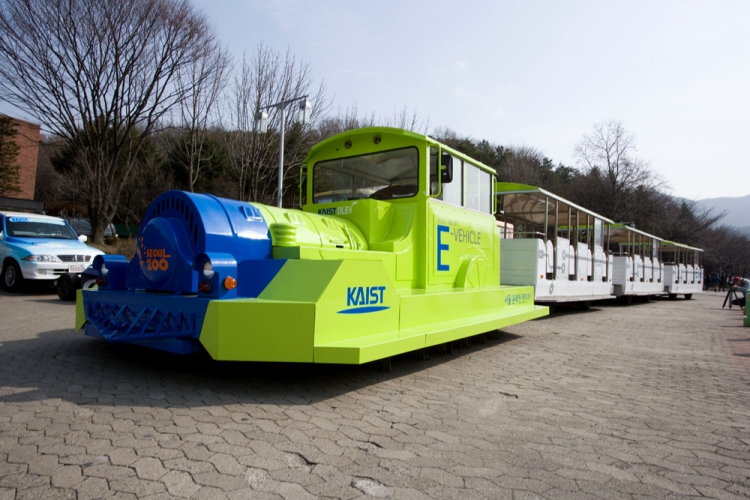 OLEV Safety Confirmed by International Standards
On September 19, KAIST announced that the electromagnetic (EM) field levels of its online electric vehicle (OLEV) measured in June and September of this year demonstrated verification of its safety.
Last June, the EM field level of OLEV installed at the Seoul Grand Park was measured by the Korea Research Institute of Standards and Science (KRISS) to test its harmfulness to human. The results were 0.5 ~ 61mG which is within the national and international standards of 62.5mG.
KRISS measured EM field levels on 22 spots on the side of and at the center of OLEV at a fixed distance (30cm) but variable heights (5cm~150cm) according to the national standard of measurement methods for electromagnetic fields of household appliances and similar apparatuses with regard to human exposure (IEC 62233).
In addition, another testing took place on September 13 following a request by National Assemblywoman Young-Ah Park, a member of the National Assembly’s Education, Science and Technology Committee, who has raised an issue on the safety of OLEV. This testing session was held by EMF Safety, Inc., an institution designated by Park, and it tested the EM field level of the same OLEV train that was tested in June.
As a result, the September measurements were well within the national and international standards with 0~24.1mG. The test was conducted under the presence of third party to produce a fair and objective result.
As reference, the EM field level results are well within the American IEEE electromagnetic field standards of 1,100 mG.
The September measurements were produced by Park’s recommendation of following the criteria specified in the measurement procedures of IEC 62110, “Electric and magnetic field levels generated by AC power systems to public exposure,” which were 15 measurements at a fixed 20cm distance at the side of and from the center of OLEV with variable heights of 50cm~150cm.
2010.09.27 View 13659
OLEV Safety Confirmed by International Standards
On September 19, KAIST announced that the electromagnetic (EM) field levels of its online electric vehicle (OLEV) measured in June and September of this year demonstrated verification of its safety.
Last June, the EM field level of OLEV installed at the Seoul Grand Park was measured by the Korea Research Institute of Standards and Science (KRISS) to test its harmfulness to human. The results were 0.5 ~ 61mG which is within the national and international standards of 62.5mG.
KRISS measured EM field levels on 22 spots on the side of and at the center of OLEV at a fixed distance (30cm) but variable heights (5cm~150cm) according to the national standard of measurement methods for electromagnetic fields of household appliances and similar apparatuses with regard to human exposure (IEC 62233).
In addition, another testing took place on September 13 following a request by National Assemblywoman Young-Ah Park, a member of the National Assembly’s Education, Science and Technology Committee, who has raised an issue on the safety of OLEV. This testing session was held by EMF Safety, Inc., an institution designated by Park, and it tested the EM field level of the same OLEV train that was tested in June.
As a result, the September measurements were well within the national and international standards with 0~24.1mG. The test was conducted under the presence of third party to produce a fair and objective result.
As reference, the EM field level results are well within the American IEEE electromagnetic field standards of 1,100 mG.
The September measurements were produced by Park’s recommendation of following the criteria specified in the measurement procedures of IEC 62110, “Electric and magnetic field levels generated by AC power systems to public exposure,” which were 15 measurements at a fixed 20cm distance at the side of and from the center of OLEV with variable heights of 50cm~150cm.
2010.09.27 View 13659 -
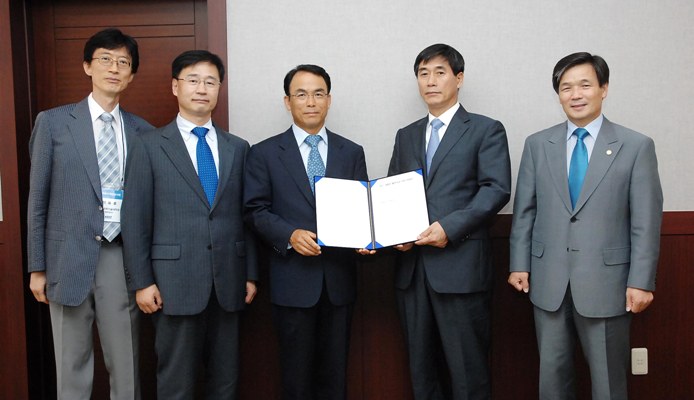 Former Minister of Information & Communications Dae-Je Jin donated to KAIST.
From left to right: Yong-Hoo Lee, Dean of Information Science & Technology College, KAIST; Gang-Seok Lee, Vice President of Skylake Incuvest, Inc.; Dae-Je Jin, Former Minister of Information & Communications; Byung-Kyu Choi, Provost of KAIST; and Dae-Joon Joo, Vice President of Planning & Budget, KAIST.
Mr. Dae-Je Jin, who had served as the Minister of Information & Communications, South Korea, gave away about 100,000 USD to KAIST and hoped that his donation would be used for the development of information and technology industry in the nation.
Mr. Jin, widely known as one of the reputable business leaders in the IT industry, was also once the president of Samsung Electronics, a leading global supplier of electronic products and goods. Currently, he runs a private equity investor called, Skylake Incuvest, Inc., which invests and incubates innovative information, communications, and technology companies.
“The real growth engine for our nation to become an economic powerhouse on a global stage has been the highly trained people who shore up our industry. Universities including KAIST have played an excellent role in providing our nation with such outstanding researchers and engineers. I will continue to support for KAIST"s mission as a leading research university in science and technology in Korea and the world,” said Mr. Jin.
KAIST said that his donation would be used for the support of its IT researches.
2010.08.27 View 12243
Former Minister of Information & Communications Dae-Je Jin donated to KAIST.
From left to right: Yong-Hoo Lee, Dean of Information Science & Technology College, KAIST; Gang-Seok Lee, Vice President of Skylake Incuvest, Inc.; Dae-Je Jin, Former Minister of Information & Communications; Byung-Kyu Choi, Provost of KAIST; and Dae-Joon Joo, Vice President of Planning & Budget, KAIST.
Mr. Dae-Je Jin, who had served as the Minister of Information & Communications, South Korea, gave away about 100,000 USD to KAIST and hoped that his donation would be used for the development of information and technology industry in the nation.
Mr. Jin, widely known as one of the reputable business leaders in the IT industry, was also once the president of Samsung Electronics, a leading global supplier of electronic products and goods. Currently, he runs a private equity investor called, Skylake Incuvest, Inc., which invests and incubates innovative information, communications, and technology companies.
“The real growth engine for our nation to become an economic powerhouse on a global stage has been the highly trained people who shore up our industry. Universities including KAIST have played an excellent role in providing our nation with such outstanding researchers and engineers. I will continue to support for KAIST"s mission as a leading research university in science and technology in Korea and the world,” said Mr. Jin.
KAIST said that his donation would be used for the support of its IT researches.
2010.08.27 View 12243 -
 South Koreans Develop High-Performance Software Router.
HPC Wire, covering news on computing software, hardware, networking, storage, tools and applications, published an article on the development of high-performance router by a KAIST research team.
The research team consisted of the Departments of Computer Science and Electrical Engineering, KAIST, presented PacketShader, a high-performance software router framework for general packet processing with Graphics Processing Unit (GPU) acceleration. PacketShader, the research team said, that exploits the massively-parallel processing power of GPU to address the CPU bottleneck in current software routers.
For the article, please click the link: http://www.hpcwire.com/news/South-Koreans-Develop-High-Performance-Software-Router-101401434.html
2010.08.25 View 11672
South Koreans Develop High-Performance Software Router.
HPC Wire, covering news on computing software, hardware, networking, storage, tools and applications, published an article on the development of high-performance router by a KAIST research team.
The research team consisted of the Departments of Computer Science and Electrical Engineering, KAIST, presented PacketShader, a high-performance software router framework for general packet processing with Graphics Processing Unit (GPU) acceleration. PacketShader, the research team said, that exploits the massively-parallel processing power of GPU to address the CPU bottleneck in current software routers.
For the article, please click the link: http://www.hpcwire.com/news/South-Koreans-Develop-High-Performance-Software-Router-101401434.html
2010.08.25 View 11672 -
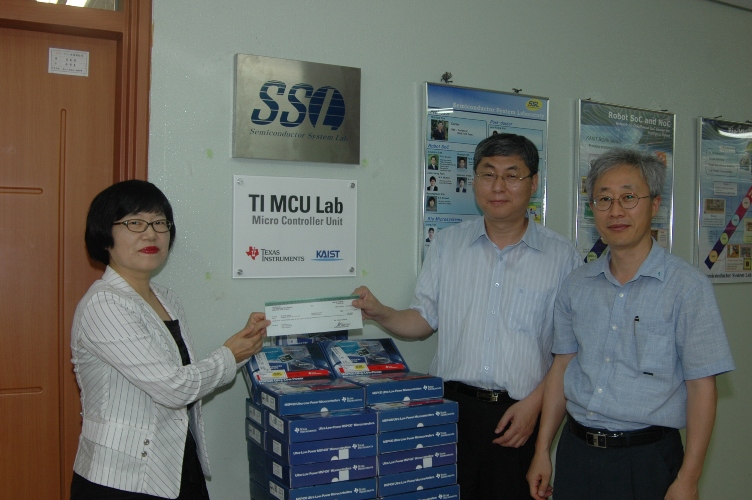 Texas Instruments, Inc. Agreed for Collaborative Research with Professor Hai-Joon Yoo, the Electrical Engineering Department of KAIST
Professor Hai-Joon Yoo from the Electrical Engineering Department of KAIST made a research collaboration agreement with Texas Instruments (TI), Inc. in July 2010 to develop a “Many-core Processor Chip,” a chip that is designed to emulate a human brain.
TI, Inc. is an American company based in Dallas, Texas and renowned for developing and commercializing semiconductor and computer technology. The company is the 4th largest manufacturer of semiconductors worldwide, 2nd supplier of chips for cellular handsets, and 1st producer of digital signal processors and analog semiconductors, among a wide range of semiconductor products.
TI, Inc. has designated Professor Yoo’s lab as one of its official labs and promised to give financial supports for the lab—it has pledged to donate a total value of 300 million won of research fund and equipment to Professor Yoo. On July 21, 2010, the signboard hanging ceremony for the designation of a TI Lab was held at Professor Yoo’s lab.
Professor Yoo developed a neuro-circuit network to emulate a human brain by adopting a mixed mode circuit that has chips for analog and digital circuits. He then has conducted a research to graft the mixed mode circuit onto a Many-core Processor to integrate the human intelligence into a conventional single-core processor that can process one instruction at a time. The Many-core Processor, once developed, can be applied to various kinds of products such as an artificial intelligence surveillance camera, robot, smart car, and the like.
Professor Yoo has presented his research results at numerous international meetings and conferences, among other things, the International Solid-State Circuits Conference (ISSCC), a global forum sponsored by the Institute of Electrical and Electronics Engineers (IEEE) for presentation of advances in solid-state circuits and Systems-on-a-Chip. The Conference offers a unique opportunity for engineers working at the cutting edge of IC design to maintain technical currency, and to network with leading experts.
Professor Yoo is a senior member of IEEE and Chairman of ISSCC in Asia.
2010.08.05 View 13495
Texas Instruments, Inc. Agreed for Collaborative Research with Professor Hai-Joon Yoo, the Electrical Engineering Department of KAIST
Professor Hai-Joon Yoo from the Electrical Engineering Department of KAIST made a research collaboration agreement with Texas Instruments (TI), Inc. in July 2010 to develop a “Many-core Processor Chip,” a chip that is designed to emulate a human brain.
TI, Inc. is an American company based in Dallas, Texas and renowned for developing and commercializing semiconductor and computer technology. The company is the 4th largest manufacturer of semiconductors worldwide, 2nd supplier of chips for cellular handsets, and 1st producer of digital signal processors and analog semiconductors, among a wide range of semiconductor products.
TI, Inc. has designated Professor Yoo’s lab as one of its official labs and promised to give financial supports for the lab—it has pledged to donate a total value of 300 million won of research fund and equipment to Professor Yoo. On July 21, 2010, the signboard hanging ceremony for the designation of a TI Lab was held at Professor Yoo’s lab.
Professor Yoo developed a neuro-circuit network to emulate a human brain by adopting a mixed mode circuit that has chips for analog and digital circuits. He then has conducted a research to graft the mixed mode circuit onto a Many-core Processor to integrate the human intelligence into a conventional single-core processor that can process one instruction at a time. The Many-core Processor, once developed, can be applied to various kinds of products such as an artificial intelligence surveillance camera, robot, smart car, and the like.
Professor Yoo has presented his research results at numerous international meetings and conferences, among other things, the International Solid-State Circuits Conference (ISSCC), a global forum sponsored by the Institute of Electrical and Electronics Engineers (IEEE) for presentation of advances in solid-state circuits and Systems-on-a-Chip. The Conference offers a unique opportunity for engineers working at the cutting edge of IC design to maintain technical currency, and to network with leading experts.
Professor Yoo is a senior member of IEEE and Chairman of ISSCC in Asia.
2010.08.05 View 13495 -
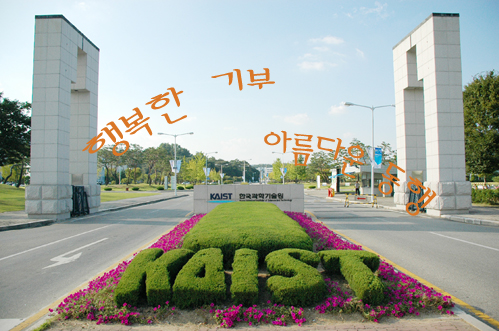 A stream of generous donations to KAIST continues to grow.
Yi-Won Oh is nothing but an ordinary person who lives in Seoul. Ever since retirement, she has looked into ways to donate her savings for a bigger cause that will benefit the people in need and the nation as a whole.
On the inauguration day of President Nam Pyo Suh who took his second term in office, Ms. Oh joined the ceremony and pledged to donate her savings to KAIST, which amounted to 10 billion won.
“I’ve always thought that the best way for our country to become a developed nation that lacks natural resources and has a small land is to develop science and technology by producing excellent manpower through a quality education. I talked to President Suh a couple of times, and we shared our common belief that the future of our nation hinges on the advancement of science and technology in Korea,” said Ms. Oh.
She added, “I support for President Suh’s vision and leadership, who has brought reformative and innovative changes to KAIST. I have no doubt that KAIST will become a leading research university in the world and play an important role in the development of our nation. It is indeed my pleasure that I can make announcement to donate my money to KAIST on the day President Suh is assigned to lead such a distinguished university one more time.”
KAIST plans to create and operate a fund dubbed “Yi-Won Oh Scholarship and Grant for Young Chair Professors.” Through the fund, talented students suffering financial difficulties and promising, young professors will have a richer opportunity to study and research.
2010.07.21 View 10793
A stream of generous donations to KAIST continues to grow.
Yi-Won Oh is nothing but an ordinary person who lives in Seoul. Ever since retirement, she has looked into ways to donate her savings for a bigger cause that will benefit the people in need and the nation as a whole.
On the inauguration day of President Nam Pyo Suh who took his second term in office, Ms. Oh joined the ceremony and pledged to donate her savings to KAIST, which amounted to 10 billion won.
“I’ve always thought that the best way for our country to become a developed nation that lacks natural resources and has a small land is to develop science and technology by producing excellent manpower through a quality education. I talked to President Suh a couple of times, and we shared our common belief that the future of our nation hinges on the advancement of science and technology in Korea,” said Ms. Oh.
She added, “I support for President Suh’s vision and leadership, who has brought reformative and innovative changes to KAIST. I have no doubt that KAIST will become a leading research university in the world and play an important role in the development of our nation. It is indeed my pleasure that I can make announcement to donate my money to KAIST on the day President Suh is assigned to lead such a distinguished university one more time.”
KAIST plans to create and operate a fund dubbed “Yi-Won Oh Scholarship and Grant for Young Chair Professors.” Through the fund, talented students suffering financial difficulties and promising, young professors will have a richer opportunity to study and research.
2010.07.21 View 10793 -
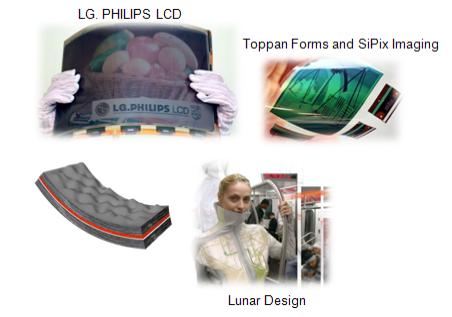 KAIST listed 27 research subjects for EEWS.
The Office of EEWS Initiative at KAIST announced 27 research projects to be implemented in 2010. The EEWS stands for energy, environment, water, and suitability.
KAIST established the EEWS Office in 2008 in efforts to solve problems facing mankind today such as depletion of natural resources, environment pollution, climate changes, water shortages, and sustainable growth. On the nationwide, the Korean government has taken initiatives to support “green growth” and “green technology” projects.
In 2009, the EEWS Office supported 24 research projects and received 28 patent rights, 6 patent registrations, and 57 Science Citation Index (SCI) papers. This year, the office chose 27 research subjects including 7 flagship projects: flexible lithium polymer batteries, spent nuclear fuel recycling, highly efficient bio-butanol, liquid electrolyte battery solid oxide fuel cell, LED lighting, artificial photosynthesis, and nano organic solar cells. New research topics begun this year include energy-saving desalination system and ultra-thin film of silicon solar cells.
Jae-Kyu Lee, Dean of EEWS Initiative Office said, “Having multiple volume of small-scaled, topic-focused research projects will encourage us to come up with large-scale convergence research projects. In so doing, we can explore new frontiers of science and technology and serve as the new growth engine for the development of green technology and industry in Korea.”
All the research projects selected will be subject to evaluations. For example, the EEWS Initiative Office will host an international workshop in September 2010 where it plans to introduce and evaluate the ongoing research projects.
2010.05.19 View 10854
KAIST listed 27 research subjects for EEWS.
The Office of EEWS Initiative at KAIST announced 27 research projects to be implemented in 2010. The EEWS stands for energy, environment, water, and suitability.
KAIST established the EEWS Office in 2008 in efforts to solve problems facing mankind today such as depletion of natural resources, environment pollution, climate changes, water shortages, and sustainable growth. On the nationwide, the Korean government has taken initiatives to support “green growth” and “green technology” projects.
In 2009, the EEWS Office supported 24 research projects and received 28 patent rights, 6 patent registrations, and 57 Science Citation Index (SCI) papers. This year, the office chose 27 research subjects including 7 flagship projects: flexible lithium polymer batteries, spent nuclear fuel recycling, highly efficient bio-butanol, liquid electrolyte battery solid oxide fuel cell, LED lighting, artificial photosynthesis, and nano organic solar cells. New research topics begun this year include energy-saving desalination system and ultra-thin film of silicon solar cells.
Jae-Kyu Lee, Dean of EEWS Initiative Office said, “Having multiple volume of small-scaled, topic-focused research projects will encourage us to come up with large-scale convergence research projects. In so doing, we can explore new frontiers of science and technology and serve as the new growth engine for the development of green technology and industry in Korea.”
All the research projects selected will be subject to evaluations. For example, the EEWS Initiative Office will host an international workshop in September 2010 where it plans to introduce and evaluate the ongoing research projects.
2010.05.19 View 10854 -
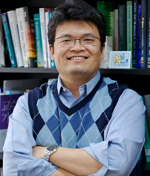 Professor Eun-Seong Kim and his research staff observed the phenomena of hysteresis and relaxation dynamics from supersolid Helium
Professor Eun-Seong Kim and his research staff observed the phenomena of hysteresis and relaxation dynamics from supersolid Helium.
Their research paper was published in Nature Physics for the issue of April 2010.
If we take Helium 4 and cool it down at temperatures below 2.176 Kelivin, liquid helium 4 undergoes a phase transition and becomes superfluid with a zero viscosity. The superfluidity was observed in solid helium through an experiment performed by researchers of Pennsylvania State University in 2004. One of the researchers then was Professor Eun-Seong Kim in the Department of Physics, KAIST.
Professor Kim and his research staff, Hyung-Soon Choi, Ph.D., recently published their research results in Nature Physics (April 2010), a highly esteemed journal in the field, on the phenomena of hysteresis and relaxation dynamics observed in supersolid Helium.
For the paper, please download the attached .pdf file.
Nature Physics link: http://www.nature.com
2010.04.13 View 13664
Professor Eun-Seong Kim and his research staff observed the phenomena of hysteresis and relaxation dynamics from supersolid Helium
Professor Eun-Seong Kim and his research staff observed the phenomena of hysteresis and relaxation dynamics from supersolid Helium.
Their research paper was published in Nature Physics for the issue of April 2010.
If we take Helium 4 and cool it down at temperatures below 2.176 Kelivin, liquid helium 4 undergoes a phase transition and becomes superfluid with a zero viscosity. The superfluidity was observed in solid helium through an experiment performed by researchers of Pennsylvania State University in 2004. One of the researchers then was Professor Eun-Seong Kim in the Department of Physics, KAIST.
Professor Kim and his research staff, Hyung-Soon Choi, Ph.D., recently published their research results in Nature Physics (April 2010), a highly esteemed journal in the field, on the phenomena of hysteresis and relaxation dynamics observed in supersolid Helium.
For the paper, please download the attached .pdf file.
Nature Physics link: http://www.nature.com
2010.04.13 View 13664 -
 News Article: Naro space rocket getting ready for second launch, April 12, 2010
News Article on KIAST published on April 12, 2010
The Korea Herald, 2010-04-12 17:07
Naro space rocket getting ready for second launch
By Bae Hyun-jung (tellme@heraldm.com)
The Ministry of Education, Science and Technology is checking on the second launch of Naro, Korea’s first space rocket, as all the necessary parts were transferred to the launch center last week.
The Science Technology Satellite No. 2 was transferred last Thursday from the KAIST Satellite Technology Research Center in Daejeon to the Naro Space Center in South Jeolla Province, said ministry officials.
The solid-fuel second-stage rocket reached the center last Monday and the liquid-fuel first-stage rocket did so on March 23. The latter was manufactured in Russia’s Khrunichev State Space Science and Production Center.
The satellite, a small one weighing 100 kilograms, was co-developed by the Korea Aerospace Research Institute, KAIST SaTReC and the Gwangju Institute of Science and Technology.
It is to revolve around the Earth for two years collecting data on climate change by gauging the hydrogen content in the atmosphere, said officials.
“With all the crucial parts ready here in the center, we have officially kicked off our final investigation before setting the details of the second Naro launch,” said a ministry official.
Second Vice Minister Kim Joong-hyun last week visited the Naro center to attend the overall inspection on all facilities related to the rocket launch.
The date has not yet been set for the second launch but will be fixed within this month, said officials.
With the general inspection completed on the facilities, the first-stage rocket and the satellite will be assembled and the combination will be joined by the second-stage rocket in May.
The first launching attempt ended in failure in August due to faulty electrical wiring or a mechanical problem in the fairing separation mechanism, according to panels.
The two fairings -- used to cover and protect the satellite placed on top of the Naro -- failed to separate timely and thus stopped the satellite from gaining sufficient velocity to reach its planned orbit.
Korea has so far spent 502.4 billion won ($428.1 million) on the Naro project since it began in August 2002.
2010.04.13 View 15283
News Article: Naro space rocket getting ready for second launch, April 12, 2010
News Article on KIAST published on April 12, 2010
The Korea Herald, 2010-04-12 17:07
Naro space rocket getting ready for second launch
By Bae Hyun-jung (tellme@heraldm.com)
The Ministry of Education, Science and Technology is checking on the second launch of Naro, Korea’s first space rocket, as all the necessary parts were transferred to the launch center last week.
The Science Technology Satellite No. 2 was transferred last Thursday from the KAIST Satellite Technology Research Center in Daejeon to the Naro Space Center in South Jeolla Province, said ministry officials.
The solid-fuel second-stage rocket reached the center last Monday and the liquid-fuel first-stage rocket did so on March 23. The latter was manufactured in Russia’s Khrunichev State Space Science and Production Center.
The satellite, a small one weighing 100 kilograms, was co-developed by the Korea Aerospace Research Institute, KAIST SaTReC and the Gwangju Institute of Science and Technology.
It is to revolve around the Earth for two years collecting data on climate change by gauging the hydrogen content in the atmosphere, said officials.
“With all the crucial parts ready here in the center, we have officially kicked off our final investigation before setting the details of the second Naro launch,” said a ministry official.
Second Vice Minister Kim Joong-hyun last week visited the Naro center to attend the overall inspection on all facilities related to the rocket launch.
The date has not yet been set for the second launch but will be fixed within this month, said officials.
With the general inspection completed on the facilities, the first-stage rocket and the satellite will be assembled and the combination will be joined by the second-stage rocket in May.
The first launching attempt ended in failure in August due to faulty electrical wiring or a mechanical problem in the fairing separation mechanism, according to panels.
The two fairings -- used to cover and protect the satellite placed on top of the Naro -- failed to separate timely and thus stopped the satellite from gaining sufficient velocity to reach its planned orbit.
Korea has so far spent 502.4 billion won ($428.1 million) on the Naro project since it began in August 2002.
2010.04.13 View 15283 -
![[Event Notice] International Workshop on Computer Science Education and Research 이미지](/pcms/common/images/common/no_img.jpg) [Event Notice] International Workshop on Computer Science Education and Research
2010 Asia-Africa International Workshop on Computer Science Education and Research
The Department of Computer Science at KAIST will host an international workshop on the education and research of computer science in Asia and Africa. The workshop, “2010 Asia-Africa International Workshop on Computer Science Education and Research” will be held on February 17-19, 2010 at a conference room located inside the KAIST Main Building. Deans of computer science departments from 13 different universities in Asia and Africa will attend the workshop.
At the workshop, participants will introduce their own education and research programs and discuss ways to have mutual collaborations. This is the first time for representatives from the computer science and engineering departments of leading universities in the newly developing countries—for instance, Thailand, Vietnam, Nigeria, Egypt, and Indonesia—to attend a meeting organized by institutions based in Korea. These countries have a large amount of natural resources and great potential to grow as a front runner in the information technology (IT) sector.
Professor Key-Sun Choi, Dean of Computer Science Department at KAIST, hopes that the workshop will be a place where participated universities discuss mutual cooperation and collaboration; exchange their ideas and knowledge of course management and education and research experiences; and share their vision of global leadership to advance the development of computer science and engineering.
Dean Choi mentioned that his department has also had consultations with the Korean government regarding a possible exchange program to select 10 or 20 members of faculty and students from universities in the newly developing nations for a doctoral course at KAIST. The exchange program, he said, would attract many of excellent candidates from nations with an emerging market for the IT industry to study at KAIST. The highly trained workforces who finish the KAIST doctoral program will contribute not only to their nations’ IT development but also to Korea’s.
2010.02.18 View 14966
[Event Notice] International Workshop on Computer Science Education and Research
2010 Asia-Africa International Workshop on Computer Science Education and Research
The Department of Computer Science at KAIST will host an international workshop on the education and research of computer science in Asia and Africa. The workshop, “2010 Asia-Africa International Workshop on Computer Science Education and Research” will be held on February 17-19, 2010 at a conference room located inside the KAIST Main Building. Deans of computer science departments from 13 different universities in Asia and Africa will attend the workshop.
At the workshop, participants will introduce their own education and research programs and discuss ways to have mutual collaborations. This is the first time for representatives from the computer science and engineering departments of leading universities in the newly developing countries—for instance, Thailand, Vietnam, Nigeria, Egypt, and Indonesia—to attend a meeting organized by institutions based in Korea. These countries have a large amount of natural resources and great potential to grow as a front runner in the information technology (IT) sector.
Professor Key-Sun Choi, Dean of Computer Science Department at KAIST, hopes that the workshop will be a place where participated universities discuss mutual cooperation and collaboration; exchange their ideas and knowledge of course management and education and research experiences; and share their vision of global leadership to advance the development of computer science and engineering.
Dean Choi mentioned that his department has also had consultations with the Korean government regarding a possible exchange program to select 10 or 20 members of faculty and students from universities in the newly developing nations for a doctoral course at KAIST. The exchange program, he said, would attract many of excellent candidates from nations with an emerging market for the IT industry to study at KAIST. The highly trained workforces who finish the KAIST doctoral program will contribute not only to their nations’ IT development but also to Korea’s.
2010.02.18 View 14966